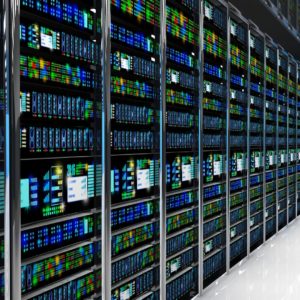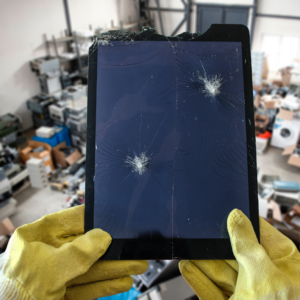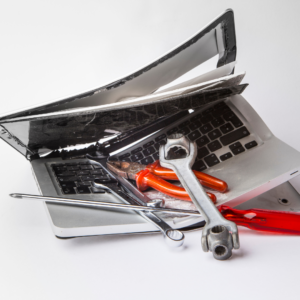Have you ever asked the question, “How are electronics recycled?” If so, it’s time to finally get an answer!
Whether you are wondering how electronics recycling differs from other forms of recycling or what happens to the rare earth elements found in electronics, then this article is for you. Keep reading to learn every step in the electronics recycling process, from start to finish.
Let’s start by talking about what it means to recycle electronics.
What is Electronics Recycling?
Simply put, electronics recycling is the process of collecting, sorting, and recycling electronics with the intent of repurposing salvageable properties in the electronics (through the recycling process).
This process also aims to protect the environment from potentially toxic properties ending up in landfills and leaching into the air, soil, and water.
Furthermore, electronics recycling serves to properly destroy private data that is stored within the old electronics. This keeps companies safe from data breaches, identity theft, and information leaks!

Types of Recyclable Electronics
When you think of the types of recyclable electronics, the first thought that comes to mind is probably your smartphone or laptop. Yes, these are great electronics to recycle!
In today’s modern, tech-savvy world, there are plenty of high-end electronics that are recyclable, including:
- Computers
- Tablets
- Cell phones
- Televisions
- Radios
- Other smart devices

But, there are so many other types of electronics that can go through the recycling process too. Some of these may include:
- Air conditioners
- Heaters
- Microwaves
- Batteries
- Digital cameras
- Calculators
- Circuit boards
- Monitors
- VCRs/DVD players
- Telephone equipment
And the list goes on! In fact, many businesses are sitting on a treasure-trove of recyclable old office electronics like desktop computers and printers.
The Step-By-Step Electronics Recycling Process
Now that you know what electronics recycling is and what types of electronics can be recycled, it’s finally time to answer the question, “How are electronics recycled?”
Read on to discover each step in the electronics recycling process.
1. Collect Electronics
First and foremost, you have to collect electronics to recycle them. These old electronics can be found anywhere technology is used, including:
- In the home
- At the office
- Schools
- Hospitals
- Agencies (ex. Digital advertising agencies)
- Manufacturing facilities
- Etc.

If you want to create an electronics recycling campaign at your company, all you have to do is set up a corporate electronics recycling plan and get your employees on board with the initiative. Once you have a solid plan, the collection of old electronics around your facility or office will be much more streamlined.
2. Transport Electronics to Certified Electronics Recycler
Arguably one the most important steps in the process is the transportation of the electronics to an accredited electronics recycler. You want to make sure that you send your old electronics to a specialized facility that is capable of wiping private data from your devices before the recycling process.
Furthermore, you need to ensure the facility is environmentally friendly and is committed to proper electronics recycling protocols.
Next, many recycling facilities will offer transportation services to come and pick up the electronics for you – especially if you have a lot of heavy electronics to recycle. Otherwise, you can drop off the electronics yourself.
3. Shred Electronics
Once the electronics arrive at the recycling facility, they are categorized and shredded. Oftentimes, the shredding process is done manually, as each electronic device is meticulously taken apart and examined.
After the electronics are broken down piece by piece, they are then sorted.
4. Sort Electronics
You might be wondering why the electronics aren’t sorted before they are shredded. Well, the shredding process is actually important to complete first because the different elements that make up the electronic device need to be extracted.
Confusing? Let’s put it this way.
Some electronics may be composed of a variety of metals, plastics, glass, compounds (like fluorescent light, toner cartridges, etc.), and other elements. In order to sort these components, the electronics must be taken apart first. Then, these elements are sorted by category and recycled.
In this step, hazardous materials (like cathode ray tubes) are removed before the objects are sent further down the recycling process.
5. Dust Extraction
Next, the pieces left over from the electronics are then placed on a conveyor belt to undergo a process called dust extraction. The pieces are spread and shaken on the belt and then dust particles are collected and thrown away.
The reason for this procedure is to ensure no environmental degradation takes place during the recycling process.
6. Magnetic Separation
After the dust has been extracted, it’s time for the magnetic separation of ferrous and non-ferrous metals. During this step, large magnets are used to suck up iron and steel and separate them from other materials.
Since metal is recycled separately from plastic, this process is a vital part of the procedure.
7. Water Separation
Once the magnets separate metal from other materials, water separation takes place. In this step, hydraulics are used to separate glass from plastic in a safe and efficient way.
In the same way metal and plastic are recycled differently, so is glass!
8. Purification
To ensure all of the elements are broken down and recycled properly, the waste is analyzed and refined even further to improve its quality.
For example, if the electronics recycling facility has the capacity to melt down metals in-house, they will usually examine the pieces to strip away any rust, paint, or other compounds found on the metal. Then the metal can be melted and refined in a more efficient way.
Refinement of Rare Earth Elements
Depending on the recycling facility the electronics are sent to, the electronics might go through chemical reactors that extract rare earth elements found within them (such as neodymium and dysprosium).
Through the extraction and refinement process, it ensures that rare earth elements are not able to leach out into the environment and negatively affect plants, animals, or humans.
9. Prep for Resale
Last but not least, when the electronics are finally broken down to their simplest form, all of the elements are either recycled by their category within the same facility (metal, plastic, paper, glass, etc.) or they are transported and sold to other facilities that repurpose the materials.
Recycle Your Electronics with Great Lakes Electronics
Now that you know how electronics are recycled, it’s time to do your part and send in your old electronics to be recycled.
Through Great Lakes Electronics Corporation, you can ensure your electronics are properly recycled and any data found within them is completely wiped and destroyed. Request a quote or call 888-392-7831 to see how easy it is to recycle your old electronics!
For a compact version of this article, please feel free to download the infographic below for yourself or to share with your colleagues.

